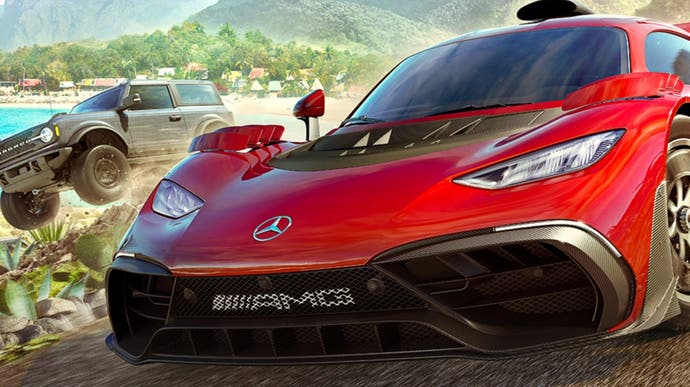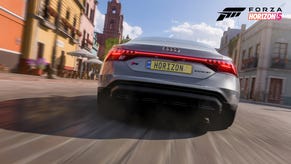Every console tested: can Xbox One really run Forza Horizon 5?
Four different machines, six different modes - and we've played them all.
We called it an Xbox Series X masterpiece and that isn't hyperbole - Playground Games has delivered a phenomenal game and a sensational audio-visual experience for its flagship console. However, this is a cross-gen release: somehow, Forza Horizon 5 has to run on last-gen machines and still live up to the expectations of quality expected from a first-party studio production. Admittedly, we were sceptical about its chances but Playground Games was always optimistic - and having put every version through its paces, the studio has delivered.
Quite how Playground would deliver this was always the crucial question and it was very satisfying to visit the studio a few weeks back to see exactly how it was done, my tour kicking off with a look at a remarkable cross-platform comparison system the studio developed. Using one controller and a network of Xbox consoles, I was able to see the demanding jungle stage of the intro drive playing out in real-time across five of the six iterations of the game, with the debug camera used to zero in on the various rendering techniques Playground had developed for the game. From there, moving from left to right, I could see how each console delivered the scene: Xbox Series X quality and performance, Series S equivalents, then finally, the base Xbox One. Xbox One X? I didn't see that but I needn't have worried, it's a fitting send-off for the Microsoft's first 4K console.
The set-up I saw is testament to the time and effort Playground has put into ensuring a decent experience for every console. Essentially and perhaps not surprisingly, it's all about scalability. The core technologies developed for Forza Horizon 5 look phenomenal on Series X but almost all of them are present in a lower precision form on the base Xbox One. Proper volumetric lighting is added, for example. It's of a much higher resolution on Series X, but it's still there on Xbox One - with an added post-process pass to eliminate low res artefacts. The brand new surfel-based global illumination system - that's there too. Probably the most noticeable difference at the core system level is foliage lighting: Playground developed a new system to simulate how light passes through vegetation and it's present on all systems, except Xbox One.
A key aspect of Forza Horizon 5's visual appeal is its sheer density and its massive vistas, something Xbox One cannot hope to deliver to the same level of fidelity as its Series counterparts. Playground's solution is intriguing. Far-off detail is still rendered to an impressive degree, and as it's a persistent aspect of the scene's visual make-up, it has to be - it sells the scale of the open world. Closer to the player, that's where the cuts are more evident. The ground has far fewer layers to it compared to the other consoles, looking rather flat at slow speeds (it's far less noticeable in the thick of gameplay, however). Actual in-world detail takes a significant hit with level of detail transitions more evident - barrelling over the open world at high speed, the pop-in is obvious and sometimes it seems that the 2D 'imposters' for world detail never get to transition to full 3D, and if they do, shading seems minimal. It's not so much of an issue in closed-circuit racing but it's in the open world that the limitations of the console start to bite.
The thing is, it still works. In fact, most of my initial play-testing was on the base Xbox One, simply because I wanted to see how Playground did it. Because it's content complete, because the key features are all included and because the result has been tailored by Playground to mask as many of the limitations as possible, it's still a worthy sequel. It also helps that the developer has retained 1080p resolution and 4x MSAA anti-aliasing: Forza titles have always looked pristine in this regard and FH5 is no exception. Dynamic resolution scaling to 810p is there (DRS being a first for Forza titles as far as I'm aware) but it's a tool of last resort as opposed to a core element of the visual make-up. In fact, Playground deploys what it calls 'DRS Plus', dropping back fidelity on cube-map reflections and shadow updates before lowering resolution. That leads us onto the other aspect of FH5 on Xbox One that emphasises quality - the 30fps target frame-rate barely budges.




































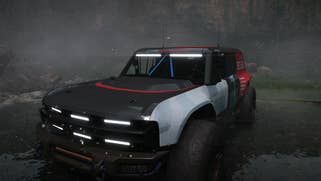



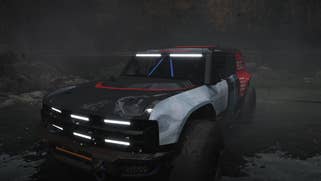

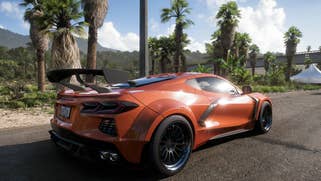
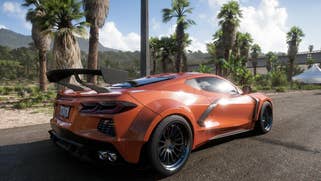
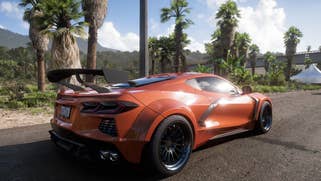
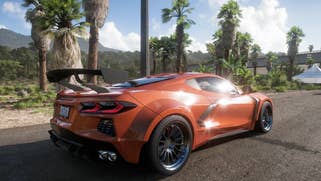
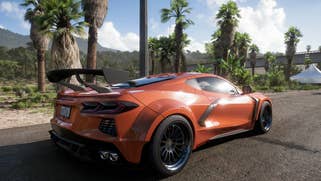
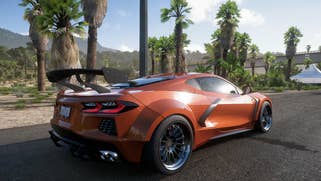






Xbox One X? I think players will be quite happy with this version. Similar to prior Forza Horizon titles, it's a 4K experience, again with 4x MSAA. DRS Plus features are still present and there's a minimum 1600p resolution, but again, frame-rate is solid at 30fps (no 60fps mode this time around, however). It took genuine effort to find any performance drops and I suspect you won't notice them in the run of play. It's not just the resolution that increases though: car quality is improved, world detail is frankly on another level compared to Xbox One, shading quality is much better. Yes, you're limited to 30fps but I found that Xbox One X delivered visual features often on par with the 60fps performance modes on the Series consoles. On paper, this makes sense - Series X with 12TF of GPU compute power delivers a 60fps experience that a 6TF console runs at 30fps instead.
In my tests I found that - generally speaking - there are three tiers of graphics fidelity on the consoles. Xbox One is at the base of the pile, as you may expect, but still gets the job done. Xbox One X's graphics profile at dynamic 4K is broadly equivalent to the Series machines in their 60fps modes - but each version has its own plus and minus points. In some areas, Series X's performance mode seemed to deliver improved ground detail over Xbox One X. Elsewhere, Series S's textures didn't look as detailed as Xbox One X's (and resolution is lower at a dynamic 810p-1080p). Series X performance mode matches One X's 1600p-2160p DRS Plus profile - however, I do want to stress again that resolution changes are difficult to track by eye. It's also nigh-on impossible to find any drops from the target 60fps in the Series console performance modes.
The final graphics 'tier' is delivered on the new consoles in their quality modes, which run at 30fps. However, thanks to low input lag and a phenomenal motion blur implementation with a nigh-on perfect shutter speed, this 30fps mode is the best I've seen. That's combined with an increase to fidelity that is simply sensational: level of detail transitions are handled more adeptly, making them barely noticeable in most cases, emphasising the integrity of the world Playground is rendering. It counts for a lot. World density is on another level - particularly in foliage heavy scenes. Stacking up Xbox One against Series X, it's almost like looking at two completely different interpretations of the same scene. In order to keep gameplay parity, collision-sensitive objects are the same but beyond that, the gloves are off on Series consoles - the Gran Caldera and jungle areas in particular are so rich in detail.
However, even at this upper tier, Series X has a number of graphical flourishes you won't see on Series S - improvements beyond resolution alone. Percentage closer shadows are a good example, with the shadows becoming more diffuse the further they are from the object casting them - a subtle improvement, but a big jump in realism up against standard shadow maps. There's also cone-step mapping, adding additional detail and depth to surfaces. Every time you find a new area, I urge you to dip into photo mode in Series X quality mode - John Linneman's tech showcase video demonstrates just how much fidelity there is in Forza Horizon 5, whether you're poring over the details in photo mode or bombing your way across Mexico at 200mph. This is where the new DirectStorage APIs help: they're used to streamline game data streaming and are essential in delivering that much detail at those incredible speeds. Another Series X advantage in quality mode is straightforward enough: there's more memory compared to Series S, so texture quality looks appreciably higher.
Where there is parity is in hardware-accelerated ray tracing: whether you're in the garage or in the Forza Vista mode at your home, both Series X and S consoles feature hardware RT features in quality mode. In this case, the game's already impressive real-time reflections are augmented with self-reflections from the vehicles - a subtle but impressive addition, and one that I'd hope to see added to the quality mode in-game (definitely on PC if it's not technically viable on consoles).
Crucially, there are advantages to playing Forza Horizon 5 on Series consoles that aren't just about graphics or frame-rate. Hosting the game on SSD makes for a more streamlined experience on Series consoles - and it's noticeable right from the beginning of the experience. The intro drive is a Playground staple, a spectacular preview of the action to come. It's a glorious, seamless, load-free experience on Xbox Series machines, but Xbox One consoles simply can't deliver the data for each new stage in time, leading to 20-35 second pauses from one segment to the next. It looks the part, but the loading delays interrupt the flow and don't leave the best impression. While these transitions are indeed instant on the new consoles, there is still loading in the main game but it's much faster than last-gen console equivalents - around 3x to the better in my tests.
Ultimately, Playground has delivered an excellent game for all Xbox systems. The surprise package for me was Xbox One X - level of detail pop-in and longer loading are blemishes but perhaps it's only because these areas of the game are so dramatically improved on Series hardware. Graphically, it's a treat, and the Scorpio Engine continues to surprise in its ability to service a 4K display. Xbox One? Judged on its own merits, it's a good version of the game and a worthy sequel. The fact that it retains Forza's signature 1080p 4x MSAA image quality and a consistent 30fps helps immensely in mitigating some of the more obvious cuts - it adds immensely to the overall polish. Series S? Quality mode looks excellent, performance mode is locked at 60fps and for those still gaming on 1080p displays, I can't foresee any complaints.
However, Forza Horizon 5 is on another level on Xbox Series X and it's one of the few games where I prefer the 30fps quality mode to its 60fps equivalent. The increase in fidelity and the more graceful LOD transitions combined with the upgraded visuals elevate it significantly beyond performance mode. True, it's not 60fps but the motion blur is the best I've seen in bridging the gap. Of course, it is possible to play this game at full frame-rate with Series X's mixture of high, ultra and extreme settings - and that's where the PC version comes into play. We'll be reporting back on our testing and experiences there soon.
